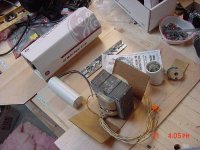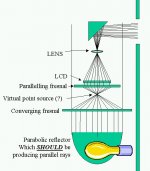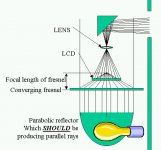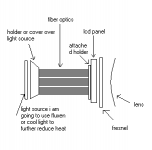daaaaaaamnnn! this thing hasnt moved in 3 days! 😕
i guess you guys got your fingers shocked from the MH ballasts and cant type. It happens... 😀
i guess you guys got your fingers shocked from the MH ballasts and cant type. It happens... 😀
I was kinda wondering too why no posts. People are just so busy working they don't have time to post. Has anyone got shocked by a MH ballast before wouldn't that be enough voltage to kill you?
probably, those things can build up a hefty charge. i've been shocked by 110V and it sticks to you for a sec or two. so i can imagine what a MH balast is capable of...
ap0the0sis
ap0the0sis
i've been done with three phase 🙁 my arm was numb for about 5 minutes!! (not to mention a helluva shock when it first happened.. 🙂 )
it wasn't on a projector tho 🙂
it wasn't on a projector tho 🙂
Careful guys.
We dont want to loose any of you.
BTW all joking aside safety is an important issue. Most guys if you are anything like me are so keen to get things going that sometimes the important safety issues can take a back seat. Things like no exposed live wires and using proper connector blocks to connect wires without leaving stray bits of live wire sticking out. And tape them up properly. Only takes a few seconds.
Things like that. Maybe just take an extra minute to make you systems safe because its not only you that could get a shock. Might be the lady of the house or small children.
One very useful tip if you are working on live cables or poking around potentially live wires is always keep one hand in your pocket. That way its unlikely you will get a direct electrical path between both hands. Which of course passes right through your heart. If thats too hard pull the plug and leave it right where you can see it.
We dont want to loose any of you.
BTW all joking aside safety is an important issue. Most guys if you are anything like me are so keen to get things going that sometimes the important safety issues can take a back seat. Things like no exposed live wires and using proper connector blocks to connect wires without leaving stray bits of live wire sticking out. And tape them up properly. Only takes a few seconds.
Things like that. Maybe just take an extra minute to make you systems safe because its not only you that could get a shock. Might be the lady of the house or small children.
One very useful tip if you are working on live cables or poking around potentially live wires is always keep one hand in your pocket. That way its unlikely you will get a direct electrical path between both hands. Which of course passes right through your heart. If thats too hard pull the plug and leave it right where you can see it.
MH Ballasts...
Since there's a lull in productivity and we're on the topic of safety, here's a question: With one of those hulking 400W ballasts, when it's plugged in a the bulb's a-glowin', are there any components that shouldn't be touched?
Obviously, the bulb is hot, but what about the coil? Or it's block? Or the capacator encased in the plastic housing? Any of that ready to shock or burn?
I'd rather find out from you than by accident.
Thanks,
dave
Since there's a lull in productivity and we're on the topic of safety, here's a question: With one of those hulking 400W ballasts, when it's plugged in a the bulb's a-glowin', are there any components that shouldn't be touched?
Obviously, the bulb is hot, but what about the coil? Or it's block? Or the capacator encased in the plastic housing? Any of that ready to shock or burn?
I'd rather find out from you than by accident.
Thanks,
dave
Attachments
Going for broke this weekend...
If I can get a few hours in the workshop, I'm going for the gusto with my setup. I've had limited (low light output) success with my configuration so far, so I've devised a new approach (see the attached pic)
With the suggestions from this forum, I'm going to presume I can obtain parallell light from the bulb & reflector (I'm going to have to cut into the sides of the reflector bowl to allow for the bulb to be mounted horizontally. The practical upshot of this is that it;ll give some space for airflow in one side of the reflector and out the other.
Then I'll use the ohp fresnal upside down to condense the rays. I'll then re-mount the original lcd's fresnal back into place on the underside of the panel. (this is the fresnal that came with the panel inside the Telex Firefly P250.
Then on through the OHP optics/mirror head and onto the wall.
IF this doesn't work, I'll have to try the "2.5x glass magnifier infront of the bulb" method of obtaining a point source, which will eliminate the ohp fresnal from the setup.
(In desparation, I"ve started pricing the panasonic PT-AE100. My confidence is slippping. Must... remain... vigilant...)
If I can get a few hours in the workshop, I'm going for the gusto with my setup. I've had limited (low light output) success with my configuration so far, so I've devised a new approach (see the attached pic)
With the suggestions from this forum, I'm going to presume I can obtain parallell light from the bulb & reflector (I'm going to have to cut into the sides of the reflector bowl to allow for the bulb to be mounted horizontally. The practical upshot of this is that it;ll give some space for airflow in one side of the reflector and out the other.
Then I'll use the ohp fresnal upside down to condense the rays. I'll then re-mount the original lcd's fresnal back into place on the underside of the panel. (this is the fresnal that came with the panel inside the Telex Firefly P250.
Then on through the OHP optics/mirror head and onto the wall.
IF this doesn't work, I'll have to try the "2.5x glass magnifier infront of the bulb" method of obtaining a point source, which will eliminate the ohp fresnal from the setup.
(In desparation, I"ve started pricing the panasonic PT-AE100. My confidence is slippping. Must... remain... vigilant...)
Attachments
hi Daveb,
if you can produce parallel light from your parabolic reflector, according to your drawing, you don't need that 2 fresnel panel!
If you want all parallel light goes to your objective lens after passthru LCD panel, then you can put fresnel panel at 1" after the LCD (make sure fresnel has fl. > obj. lens fl.)
See you.
if you can produce parallel light from your parabolic reflector, according to your drawing, you don't need that 2 fresnel panel!
If you want all parallel light goes to your objective lens after passthru LCD panel, then you can put fresnel panel at 1" after the LCD (make sure fresnel has fl. > obj. lens fl.)
See you.
Gunawan,
I think I do need the fresnels, and here's why:
The reflector has a diameter of about 15", and I want to capture as much of that light as possible and force it through the 6.4" diagonal LCD screen. Tell me If I am mistaken.
And here's yet another question: If I've got to change my objective lens, I'm wondering about the 5 7/8" lens that some have obtained from Surplus Shed (which doesn't seem to be available any longer). What is its focal length, and why have I not heard about any spherical abberabtion that is supposed to be inherent to single lens setups?
And something else: People have spoken at length about the DELTA 20 CRT lens. I've found a Delta IV lens. looks the same, but I can't find any reference to it. Anyone know if it's in the same ballpark?
dave.
I think I do need the fresnels, and here's why:
The reflector has a diameter of about 15", and I want to capture as much of that light as possible and force it through the 6.4" diagonal LCD screen. Tell me If I am mistaken.
And here's yet another question: If I've got to change my objective lens, I'm wondering about the 5 7/8" lens that some have obtained from Surplus Shed (which doesn't seem to be available any longer). What is its focal length, and why have I not heard about any spherical abberabtion that is supposed to be inherent to single lens setups?
And something else: People have spoken at length about the DELTA 20 CRT lens. I've found a Delta IV lens. looks the same, but I can't find any reference to it. Anyone know if it's in the same ballpark?
dave.
Gunawan is correct. You would only need ONE converging fresnel lens (ala "page magnifier") if the reflector produces parallel rays. Two would give poor results in that setup.
I haven't been following the thread for some time now, so I'm sure I am repeating old topics...but CRT lenses really aren't well-suited to most applications. For a proven solution, look for an OHP lens, or at least aspheric lens of appropriate focal length to avoid chromatic aberrations.
-f4
I haven't been following the thread for some time now, so I'm sure I am repeating old topics...but CRT lenses really aren't well-suited to most applications. For a proven solution, look for an OHP lens, or at least aspheric lens of appropriate focal length to avoid chromatic aberrations.
-f4
fender4 said:Gunawan is correct. You would only need ONE converging fresnel lens (ala "page magnifier") if the reflector produces parallel rays. Two would give poor results in that setup.
I haven't been following the thread for some time now, so I'm sure I am repeating old topics...but CRT lenses really aren't well-suited to most applications. For a proven solution, look for an OHP lens, or at least aspheric lens of appropriate focal length to avoid chromatic aberrations.
-f4
Curious,
what does chromatic aberrations mean(in simple english of course)? 😀
Multiplexor
what does chromatic aberrations mean(in simple english of course)?
Different light colours get bent slightly differently by single glass lenses so you see colour fringing on a projected image.
Cheaper OHP use a single lens but better ones use two or three lenses cemented together for colour correction. Costs more but looks better.
My OHP uses a single lens (3m 1705) and there is some aberration but you have to look real hard to see it.
what does chromatic aberrations mean(in simple english of course)?
Different light colours get bent slightly differently by single glass lenses so you see colour fringing on a projected image.
Cheaper OHP use a single lens but better ones use two or three lenses cemented together for colour correction. Costs more but looks better.
My OHP uses a single lens (3m 1705) and there is some aberration but you have to look real hard to see it.
Daveb,
in this last drawing, there is a much to short FL of the fresnel.Is this really an OHP setup? If you watch the light pyramide going out of the fresnel the, apex of the pyramide, which is the focal point should be at the objectives plain. But then, of course there is wasted a lot of light outside of panel area!
Looking at the 2. pyramide going up from LCD to objective:This 2. pyramide isn't supported by the light path! If it was, the light rays would match with these of the 1. pyramide!
So you have no other choice than:
a) take a fresnel, which has the focal point at objective lens and blockout the unused light with a blind at the fresnel' state
b) try an objective with shorter FL
c) prolonge the fresnels FL with a second fresnel with negative FL
For a better light efficiency the reflector could be smaller, so that the overall aperture decreases in size. Condensors don't need to be larger than the LCD.
If you have OHP setup, then the parabolic reflector completely changes the light path. In common OHPs the point lightsource allows the apex of the light pyramide to be shifted towards the objective. Using parallel rays from a parabolic reflector, there's only one place where the apex can be, and thats the focal point of the fresnel. But this point isn't the objective of the OHP!
Hope you understand my rough explanations!
xblocker
in this last drawing, there is a much to short FL of the fresnel.Is this really an OHP setup? If you watch the light pyramide going out of the fresnel the, apex of the pyramide, which is the focal point should be at the objectives plain. But then, of course there is wasted a lot of light outside of panel area!
Looking at the 2. pyramide going up from LCD to objective:This 2. pyramide isn't supported by the light path! If it was, the light rays would match with these of the 1. pyramide!
So you have no other choice than:
a) take a fresnel, which has the focal point at objective lens and blockout the unused light with a blind at the fresnel' state
b) try an objective with shorter FL
c) prolonge the fresnels FL with a second fresnel with negative FL
For a better light efficiency the reflector could be smaller, so that the overall aperture decreases in size. Condensors don't need to be larger than the LCD.
If you have OHP setup, then the parabolic reflector completely changes the light path. In common OHPs the point lightsource allows the apex of the light pyramide to be shifted towards the objective. Using parallel rays from a parabolic reflector, there's only one place where the apex can be, and thats the focal point of the fresnel. But this point isn't the objective of the OHP!
Hope you understand my rough explanations!
xblocker
diagrams
i know this is off topic, but i'd like to know what software you guys use to make your diagrams. i've had a few ideas, but don't have the patience to use any of the 'draw' type programs i have, and don't have a scanner(no space on my desk). i'd like to be able to make a reasonably accurate rendering without spending more than 20 min.
i know this is off topic, but i'd like to know what software you guys use to make your diagrams. i've had a few ideas, but don't have the patience to use any of the 'draw' type programs i have, and don't have a scanner(no space on my desk). i'd like to be able to make a reasonably accurate rendering without spending more than 20 min.
fiber optics
hi all first off i want to say i have been reading this forum for a few weeks now and i am truly impressed with the ideas that have come about, and i had a question has anyone tried to use fiber optics to concentrate the light source into the lcd panel , if done correctly i think this would do two things, one remove the heat issue from the lcd and lenses , and two you would have little light loss and most if not all the light concentrated on the lcd panel , please let me know your thoughts on this idea, sort of a socket around the lamp housing with the fiber optics connected to the front then another housing attached to the lcd panel with the fiber optics running into that. what do you think.
thanks chuck1
hi all first off i want to say i have been reading this forum for a few weeks now and i am truly impressed with the ideas that have come about, and i had a question has anyone tried to use fiber optics to concentrate the light source into the lcd panel , if done correctly i think this would do two things, one remove the heat issue from the lcd and lenses , and two you would have little light loss and most if not all the light concentrated on the lcd panel , please let me know your thoughts on this idea, sort of a socket around the lamp housing with the fiber optics connected to the front then another housing attached to the lcd panel with the fiber optics running into that. what do you think.
thanks chuck1
Greetings Chukie1
I see you are a new guy. Welcome to the board.
What you are saying here sounds pretty interesting. Could you do a diagram of what you have in mind.
Thanx
I see you are a new guy. Welcome to the board.
What you are saying here sounds pretty interesting. Could you do a diagram of what you have in mind.
Thanx
fiber optic sketch
hi guiys here is what i had in mind if you connect the fiber optics to a sort of lense cover at both the light source end and the lcd panel end you use the maximum light without losing any around the edges, also depending on how long a run of fiber optics you move the light source away from the lens and lcd making them less likely to heat up i think what do you think
hi guiys here is what i had in mind if you connect the fiber optics to a sort of lense cover at both the light source end and the lcd panel end you use the maximum light without losing any around the edges, also depending on how long a run of fiber optics you move the light source away from the lens and lcd making them less likely to heat up i think what do you think
Attachments
Re: fiber optic sketch
the only problems i can see for this after contemplating it all night is the following.
1. using the cool fluxen or ??? name for the 65w fluorecent worklight idea it still has some heat i am afraid so i think you would need to put a small set of fans in the area of the light cap to solve that problem .
2. i would like to make a same size rectangle about the dimensions of the light source and stack fiber optic strands to fill it so you get the maximum light, this could be a problem at the lcd panel end because of the amount of fibers it would take for a given lcd panel sze , but it would i believe give a perfectly even throw of light with little light lost because you have all the light channeled threw the fibers.
3.third problerm??? the fresnel can it be done to set the light source , lcd panel then the fresnel and then lens i guess you could run the fibers to the fresnel first and attach the fresnel to the lcd panel .
well this fiber optic is just part of my ideas for a projector i am starting, began this project after a not to great 100' projection tv project i have been working on , i found the plans online for free so it only cost me for materials, it is a neat experiment but i hate the problem of not being able to get the image clear enough for me so i am starting this project . i have purchased a sharp Qa-1000 panel 640x480 will this work to get things rolling 89.99 shipped with all cables power and case please let me know
thanks
chuckie1
chukie1 said:hi guiys here is what i had in mind if you connect the fiber optics to a sort of lense cover at both the light source end and the lcd panel end you use the maximum light without losing any around the edges, also depending on how long a run of fiber optics you move the light source away from the lens and lcd making them less likely to heat up i think what do you think
the only problems i can see for this after contemplating it all night is the following.
1. using the cool fluxen or ??? name for the 65w fluorecent worklight idea it still has some heat i am afraid so i think you would need to put a small set of fans in the area of the light cap to solve that problem .
2. i would like to make a same size rectangle about the dimensions of the light source and stack fiber optic strands to fill it so you get the maximum light, this could be a problem at the lcd panel end because of the amount of fibers it would take for a given lcd panel sze , but it would i believe give a perfectly even throw of light with little light lost because you have all the light channeled threw the fibers.
3.third problerm??? the fresnel can it be done to set the light source , lcd panel then the fresnel and then lens i guess you could run the fibers to the fresnel first and attach the fresnel to the lcd panel .
well this fiber optic is just part of my ideas for a projector i am starting, began this project after a not to great 100' projection tv project i have been working on , i found the plans online for free so it only cost me for materials, it is a neat experiment but i hate the problem of not being able to get the image clear enough for me so i am starting this project . i have purchased a sharp Qa-1000 panel 640x480 will this work to get things rolling 89.99 shipped with all cables power and case please let me know
thanks
chuckie1
aren't fiber optics expensive? expecially since you need so much of it?
you're planning on using a 65w fluorecent worklight as your light source? i dont think that will give you the light you need to project an image onto a wall that is 10-15 feet away. some people here are using 400W MH lamp and they claim the pic is still a bit dim so i dont see how a 65 watt worklight will work for this.
my .02 cents
ap0the0sis
you're planning on using a 65w fluorecent worklight as your light source? i dont think that will give you the light you need to project an image onto a wall that is 10-15 feet away. some people here are using 400W MH lamp and they claim the pic is still a bit dim so i dont see how a 65 watt worklight will work for this.
my .02 cents
ap0the0sis
- Home
- General Interest
- Everything Else
- The Moving Image
- DIY Projectors
- DIY Video Projector Part II



